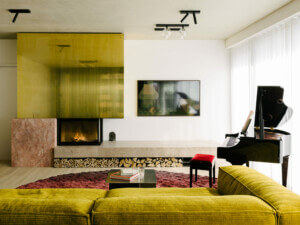It is always exciting to discover the work of an architect whose name you know from history but whose buildings remain a mystery.
This is what happened to me on a recent trip to Prague and my “discovery” of Jože Plečnik. His final 1929 building, the Church of the Most Sacred Heart of our Lord, and his small insertions in the Prague Castle were revelations and he is a new hero. But occasionally one discovers the work of an architect whose name does not even register as a footnote in traditional surveys. This is the case of the Rudolf Belling (1886-1972) who is the focus of a new exhibit at the Hamburger Bahnhof in Berlin. Belling, was, in fact, an artist, primarily a sculptor, who worked on the fringes of architecture yet produced several projects that are highly original and should be better known by architects.
His work might best be described as modernist abstraction in the manner of contemporary movements of the period like Constructivism or Expressionism. He argued, like his contemporaries, for a fusion of the arts and he worked in multiple mediums including film, interior decoration, and architecture, in addition to sculpture (his principal medium). Belling was not unknown in his time and was a member of Arbeitsrat für Kunst, the 1918 Novembergruppe, and was featured in Le Corbusier’s magazine L’Esprit Nouveau. The exhibit sets out to highlight his belief in a coming together of the arts and notion that culture and architecture were to be guided by tectonic forms rather than “natural” shapes; this was the focus of his practice and teaching. Belling, incidentally, spent several years in New York City, where he fled the Nazis and taught at the Annot Art School and Gallery in Rockefeller Center.
I addition to his stunning design (at least in the grainy photographs in the exhibition) for The Scala restaurant in Berlin, he was able to model sculpture into architecture. As Alfred Kuhn pointed out in 1927, for the first time he created “sculpture from the outside in but from the Inside out.”
His forms in space may not have been truly revolutionary for his time but he created powerful monuments that were more innovative as architecture than sculpture. His seven-meter-tall advertising sculpture (with Wassili Luckhardt in 1920/21) for the tire maker Pneumatik Harburg-Wien was a very example of how to create memorable roadside architecture and signage. His most powerful and unique architectural projects were a 1923 gas station (with Alfred Gellhorn and Martin Knauthe) for Olex and the two architectural sculptures he designed for Olex and the Villa Goldstein in 1923 (both destroyed). These brought all his influences from Constructivism to Futurism together as a single powerful work. In fact, it may be said that he brought architectural ideas back into sculpture. Finally, he produced beautiful small architecture renderings that seem decades in advance of the Pop style of architectural drawing methods.
Rudolf Belling: Sculpture and Architecture runs through September 17 at the Hamburger Bahnhof – Museum für Gegenwart – Berlin.
(The video below on Rudolf Belling: Sculpture and Architecture is available only in German.)










